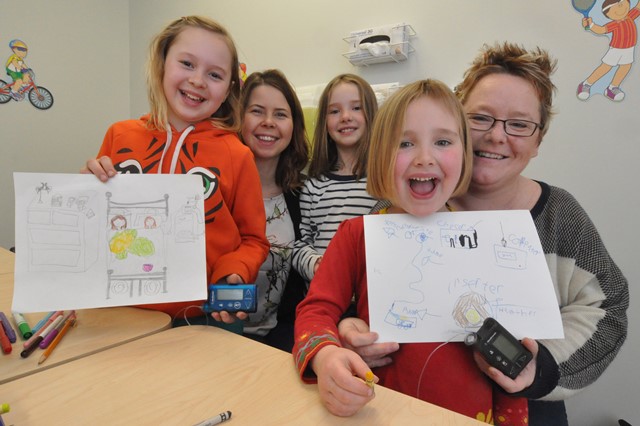Parents of children in a ground-breaking diabetes trial in London are enjoying peace of mind and a good night’s sleep for the first time in years. The North American trial is looking at ways to prevent dangerous low blood sugars overnight in children with type 1 diabetes, and it’s helping both children and parents go to bed worry free.
The study is a partnership between the Centre for Diabetes, Endocrinology and Metabolism of St. Joseph’s Health Care London and the pediatric diabetes group at Children’s Hospital, London Health Sciences Centre. Dr. Irene Hramiak, chair/chief of the Centre for Diabetes, Endocrinology and Metabolism is collaborating with Dr. Cheril Clarson, section head of pediatric endocrinology at Children’s Hospital. Both Dr. Hramiak and Dr. Clarson are also Lawson Health Research Institute scientists.
Low blood sugar, or hypoglycemia, is a condition that can lead to coma, seizures or death for individuals with diabetes, explains Dr. Hramiak. More than half of these episodes occur during sleep hours. In children, the rate is higher – 75 per cent of hypoglycemic seizures occur during sleep. Dr. Clarson describes the fear of hypoglycemia, particularly at night, as one of the most serious concerns reported by parents of children with type 1 diabetes.
The goal of the clinical trial, known as the pump shut-off study, is to test a system that mimics the pancreas to reduce the rate of nocturnal hypoglycemia. The system is a combination of an insulin pump to deliver insulin, a continuous glucose monitoring system to measure blood sugars in the patient every five minutes, and a computer algorithm (software) that predicts for each individual when they are at risk for hypoglycemia (low blood sugar).
When operating, the system avoids low blood sugar while the patient is sleeping by turning off the insulin pump when it predicts low blood sugar could occur and then turning the pump back on when there is no longer a risk of low blood sugar.
“It’s a simple solution to a major problem for individuals wearing an insulin pump,” says Dr. Hramiak, principal investigator of the trial in London – the only Canadian centre participating. “We have tested the system in adults and now are testing it in a group of 20 children ages three to 15. This system could potentially prevent overnight hypoglycemia and is a first step to developing a system that functions like a native pancreas.”
For Nicole Tracey, mom of 10-year-old Charlise, the study “has absolutely given me the ability to sleep at night. Before using the system, my first thought every time I woke up was “is she okay?” In the past if I had a good sleep I would wake up in a panic because I didn’t check on her during the night. On the other hand, on nights when I do check her three or four times during the night, I am unable to get a proper night’s sleep. With the system, I go to bed worry free and I can sleep the whole night knowing she will be okay.”
MORE: SERVICE SUPPORTS MUSLIMS WITH DIABETES
Anne Crosby, mom of six-year-old Heather, is also going to bed with peace of mind. “My daughter has had a lot of lows during the night and when we are sleeping we don’t realize she is dropping low. It can be very scary. The study has helped to give her better control and I can relax because I know the system will stop her from dropping too low.”
Funded in Canada by the JDRF Canadian Clinical Trial Network, the trial is also underway at Stanford University and the University of Colorado in the U.S. A total of 45 adults have been previously studied and now a total of 90 children are being studied. The pediatric trial is expected to be completed in September 2014.
Future plans for pump shut off studies will address high blood sugar – or hyperglycemia – in addition to low blood sugar, first in adults, then in children.




